















Traffic Tech #316: Pilot Test of - Heed the Speed, a Program to Reduce Speeds in Residential Neighborhoods |
|---|
|

There is abundant evidence that higher speeds are associated with more severe pedestrian injuries and increased death. Surveys show that drivers believe that speeding is more dangerous for pedestrians on residential roads than on other roadways.
There has been significant work on engineering approaches to traffic calming as a means of reducing neighborhood speeds. There have, however, been few attempts to combine public information, enforcement, and innovative marking techniques with engineering changes as a means of achieving greater speed reductions. NHTSA therefore funded the current study whose objective was to develop and test a behavior-based program to reduce motorist speed in residential areas by adding education and enforcement to engineering.
Some communities have used traffic calming on selected streets in a neighborhood but left others untouched because of objections voiced by emergency services. This creates streets within a defined calmed neighborhood where motorists continue to exceed prudent speeds – or at least exceed the speeds on adjacent calmed streets. The focus of this study was therefore to examine whether enforcement and education techniques could achieve a meaningful speed reduction on untreated streets adjacent to streets that have received traditional traffic calming treatments.
Dunlap and Associates, Inc. conducted the field study in two adjacent cities: Phoenix (six road segments) and Peoria (four road segments), Arizona. Three neighborhoods were selected in each city based on the expressed desires of the residents to moderate vehicle speeds and/or a history of excessive speeding. Multiple roads were part of the study in some of the six areas.
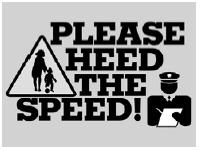
Heed the Speed was selected as the slogan for the program and a logo was designed. Educational materials were developed for the program including street and lawn signs (see left) that displayed the slogan and logo, print materials for homeowners, parents and drivers (including high school drivers), press releases for the two cities, inputs for homeowner’s association newsletters, and radio spots. Earned media included write-ups in local papers and participation in local television programs.
The police increased enforcement patrols and tickets for speeding violations. They also added numerous “warning stops” for motorists who exceeded the speed limit but drove below the range at which a stop would normally have been made. Enforcement activities also included training citizens to conduct neighborhood speed watches and deployment of speed trailers and photo speed enforcement vans.
Roadway treatments included installation of speed humps and tables in two of the neighborhoods. Two types of innovative roadway visual treatments were also tried– 3-D Pavement Markings that created the illusion of raised objects in the roadway and Tyregrip™ coating that simulated a speed table (see below).
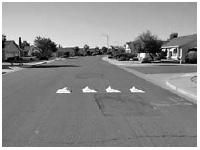 |
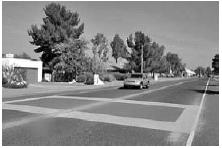 |
|
3-D Pavement Marking |
Tyregrip™ Coating |
The program was evaluated by a pre/post mailed survey, by police data forms completed at each stop, and by multiple waves of speed measurements using on-road traffic counters. The survey showed a strong increase in knowledge of the program, awareness of enforcement efforts, and acceptance of the need to moderate speeds. Respondents also expressed a strong belief that speeds in their neighborhood had decreased since the Heed the Speed program was implemented.
The police stop records showed that most violators lived in or within a mile of the neighborhood in which they were stopped. Most traveled on the road on which they were stopped at least once a week.
Speed measurements showed significant reductions in all six neighborhoods and on all 10 test road segments within the neighborhoods except one low-volume street in which speed humps had been installed prior to the start of the program, and 87 percent of the motorists were already at or below the speed limit. On all other treated roads, there was a significant increase in drivers complying with the speed limit and significant reductions both in mean speed and in the percentage of vehicles traveling 7 mph or more above the speed limit. Compliance increases from the beginning to the end of the program ranged from about 17 percent to over 117 percent across the 10 test segments (see graph below).
Compliance Increase (% at or Under Speed Limit)
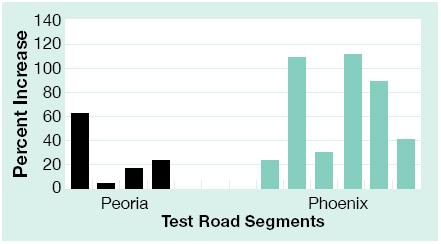
The percentage of speeding drivers converted to compliance with the speed limit ranged from 5 percent to 48 percent (see graph below).
Conversion Percent (% Speeders Brought Into Compliance)
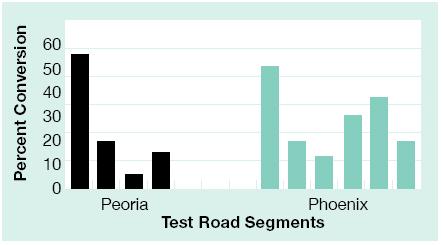
Mean speed reductions ranged from approximately 0.5mph to over 3.5 mph. The drop in the percentage of drivers exceeding the speed limit by 7 mph or more ranged from about 14 percent to over 71 percent. The extent of the speed reduction involving thousands of vehicles per day suggests that Heed the Speed programs could be effective in reducing crashes to pedestrians and in limiting the injury severity when a crash does occur.
In addition to the results of the study, a guide for designing Heed the Speed programs, sample public information & education materials, and examples of data collection forms for evaluation are included in appendices to the report.
How to Order
To download a copy of the report, Pilot Test of Heed the Speed: A Program to Reduce Speeds in Residential Neighborhoods, go to:
www.nhtsa.dot.gov/people/injury/research/HeedSpeedWeb/index.html.
For more information about the study, write to the Office of Behavioral Safety Research, NHTSA, NTI-130, 400 Seventh Street SW., Washington, DC 20590, send a fax to 202-366-7096, or contact Dr. Marvin M. Levy, 202-366-5597; e-mail: mlevy@nhtsa.dot.gov.
| TRAFFIC TECH is a publication to disseminate information about traffic safety programs, including evaluations, innovative programs, and new publications. Feel free to copy it as you wish. If you would like to receive a copy, contact Melissa Cheung, MPH, Editor, fax 202-366-7096, e-mail: melissa.cheung@dot.gov. |
